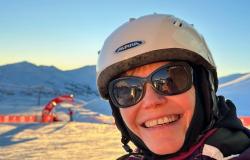April 2, 2024
‘I still sometimes ask myself what really belongs to me and what is caused by the brain injury’
Isa Sluijs (21) is doing her second study and has a part-time job in tourism. So far she is living the normal life of a twenty-something. However, a sinus thrombosis at the age of thirteen still affects her daily life.
It must have been a migraine attack, Isa Sluijs thought when she was on her way to Schiphol with her family for a Christmas holiday in Curaçao at the end of December 2015. She boarded the plane thinking that the severe headache would go away. It didn’t. During the first days in Curaçao, she did not leave her hotel room. The headache remained, her vision became impaired and she vomited. The hotel doctor also suspected migraine, but her parents did not believe it when the complaints did not diminish. They called the neurologist in the Netherlands who was already treating Isa for her migraines.
“It just so happened that the neurologist was in Curaçao a week before us and knew the neurologist on the island. He arranged for us to go to the hospital for a scan. The first outcome was that I had a brain tumor. I barely noticed it, I mainly wanted to feel less ill, but it was a huge shock for my parents. To be sure, another scan was made. It turned out that I had a sinus thrombosis, with a cerebral hemorrhage and cerebral infarction.”
Other concern
“I was in Curaçao with my grandmother, uncle and aunt, cousins, my parents and sister. My parents and sister stayed with me after the holiday week, the rest went home. My sister went back a week and a half later because she had to go to school. In total I was in the hospital for six weeks and then another week in a hotel. It was still too risky to make a long flight.
Healthcare in Curaçao is different than we are used to in the Netherlands. The doctors and nurses were caring and kind, but I had to shower with cold water and my parents had to ensure that I received my medication on time. And that I received the right medication.”
Injury
“The cerebral infarction left me with damage in the area of emotion regulation. As a result, my emotions are less well defined. When I’m happy, I’m super happy, when I feel down, that’s also extreme. That is sometimes difficult, especially for those around me. I also have known complaints such as fatigue and concentration problems.
I talked to a psychologist who specializes in acquired brain injuries. Together we tried to unravel which characteristics really belong to me and which are caused by brain damage. I didn’t know myself very well at the age of thirteen and I didn’t know whether those extreme emotions could possibly be something from puberty.
I still sometimes ask myself what really belongs to me and what is caused by the brain injury. It is now clear about some things: the fact that I experience extreme emotions was not something that teenager Isa did, because I still have them. The fact that I still like to live with my parents and find it difficult when they are not around could very well have had to do with what happened in Curaçao, but I already suffered from homesickness at the age of five. So that’s really something from me.”
Hereditary
“Exactly one year after the sinus thrombosis, I started experiencing muscle pain in my right leg. I thought it would go away with some paracetamol and a good night’s sleep. But at night it got worse and my leg became red and swollen. My parents immediately called the doctor who sent me to the hospital. I had a thrombosed leg, from my knee to my navel.
Because it was the second time in a year that I had thrombosis, they started looking further into the possible cause at the Wilhelmina Children’s Hospital. It turned out that I had the blood clotting disease Antithrombin III deficiency. Because this can be hereditary, the entire family was tested. My grandfather, mother, aunt and cousin also turned out to have it, but my sister and niece did not. Actually, it was a very logical outcome: my grandfather had already had a thrombosis, and my aunt had also had it during one of her pregnancies. My mother has not yet, but she was taking rheumatoid arthritis medication, which contains a blood-thinning substance. Last year she contracted corona, causing a pulmonary embolism.
I’m not afraid that I might later give my own children AT-III as well. It is not the case that if you have it, you are born very sick. And now that I know that it is hereditary, we could immediately test the child for it.”
Among the elderly
“It is rare to get thrombosis as a child. I discovered this myself in several ways. For example, I was initially not given DOACs, because this anticoagulant medication had not been studied in children. My doctor at the Van Creveld Clinic in Utrecht, where we ended up as a family, said at one point that we should try it anyway, because I only had to take one pill a day. That went well.
The first six months after the sinus thrombosis I was given other medication, for which I always had to go to the thrombosis service. He was in a nursing home with us in Wijk bij Duurstede. A logical place of course, because elderly people in particular suffer from thrombosis, but for me as a teenager it was a bit strange to sit among the elderly in the waiting room. Fortunately, they quickly realized at the thrombosis service that it was a bit inconvenient for me to be there at eight o’clock in the morning, because then I would have a problem with school. This allowed me to take the injection myself at home.”
Playing tennis
“Before I got thrombosis, I played hockey, but that is too risky in combination with the anticoagulation medication. Nowadays I play tennis. That’s also fun, but I’m the youngest at our club and so I mainly play with and against older people.
Because of that thrombosed leg, I cannot run for more than two minutes at a time or stand for long periods of time. For example, at a concert I always have to take a seat. Going out for long periods of time is also difficult. Not just because of standing; I still get tired and overstimulated more easily. When I go to a party, I know that I will be able to do little or nothing for a few days. Sometimes this is difficult to explain to peers who do not experience such limitations. They know little or nothing about thrombosis.
There is something that can be done about the swelling of my leg, for example by placing a stent. This was not possible at a younger age, because I had to grow up first. However, doctors do not know what the long-term effect is. For me there are too many question marks, which is why I have decided to forego a stent for the time being. And I don’t like walking anyway, so I don’t mind that I can’t do that for long.”
To study
“I currently experience few limitations. Fortunately, I am learning well despite the concentration problems. Fortunately, the teachers at my high school were very sympathetic. I was allowed to catch up on tests that I had missed and I was allowed to drop some subjects early after my absence after the thrombosis leg, so that I could focus on the subjects in the subject package that I was going to choose after the third.
Last year I completed my studies in international tourism management in Utrecht. At the beginning of this year I started a second study; a part-time Dutch teacher training course, for which I will do an internship at a secondary school. As a teacher you do not have to work full days four or five days a week. I don’t know yet whether it really suits me. I also work for a tour operator, which I also enjoy. So I can go in several directions. I’m still young, so I don’t have to make a choice yet.”
Thrombosis occurs at all ages. Read more about it in our magazine.
Request for free
With your gift you make a big difference!
Also contribute to a future without thrombosis. Support research into better treatment of thrombosis and better medicines to treat and prevent thrombosis.
Stop the gag. Stop thrombosis.
Start donating






